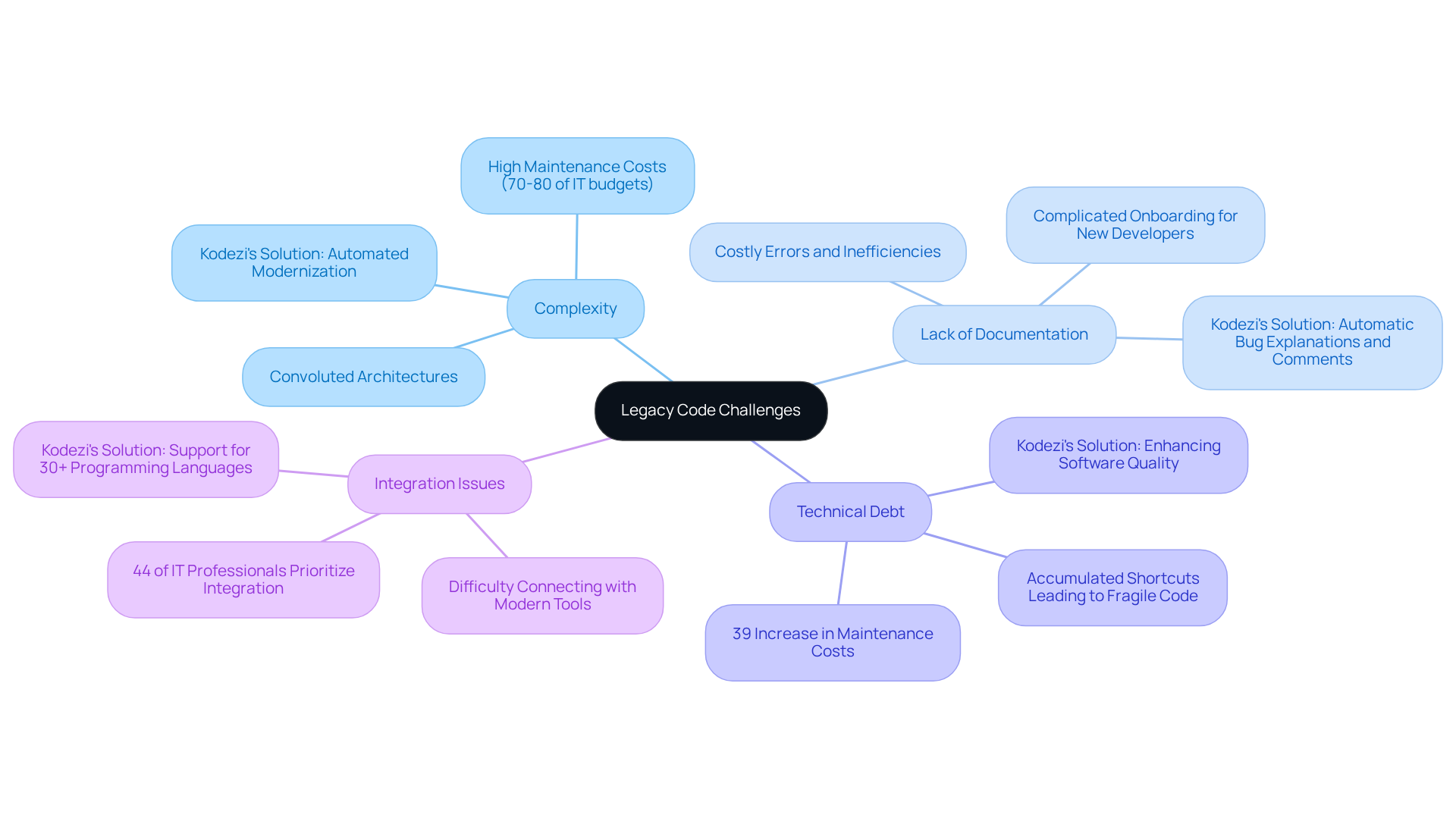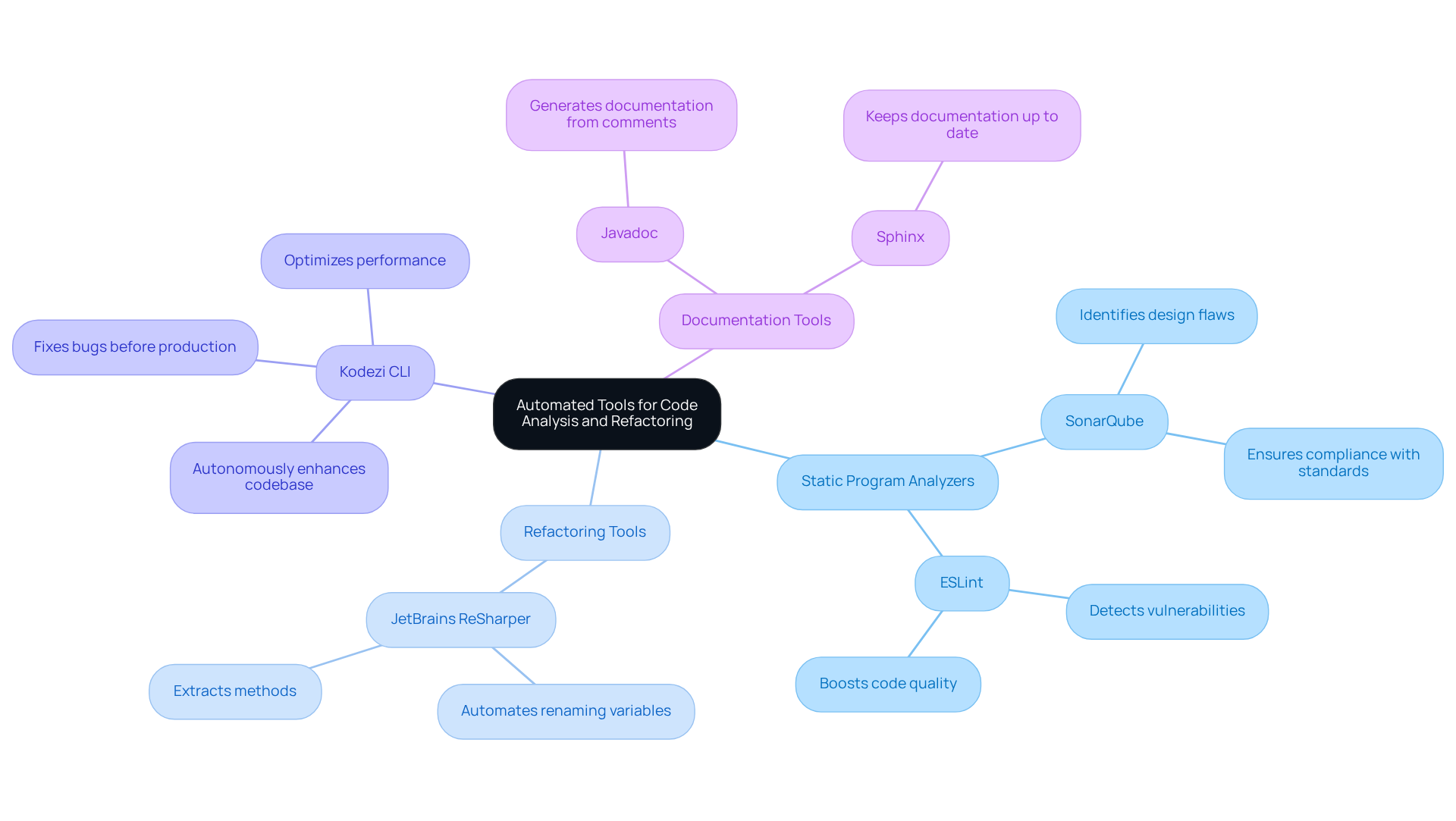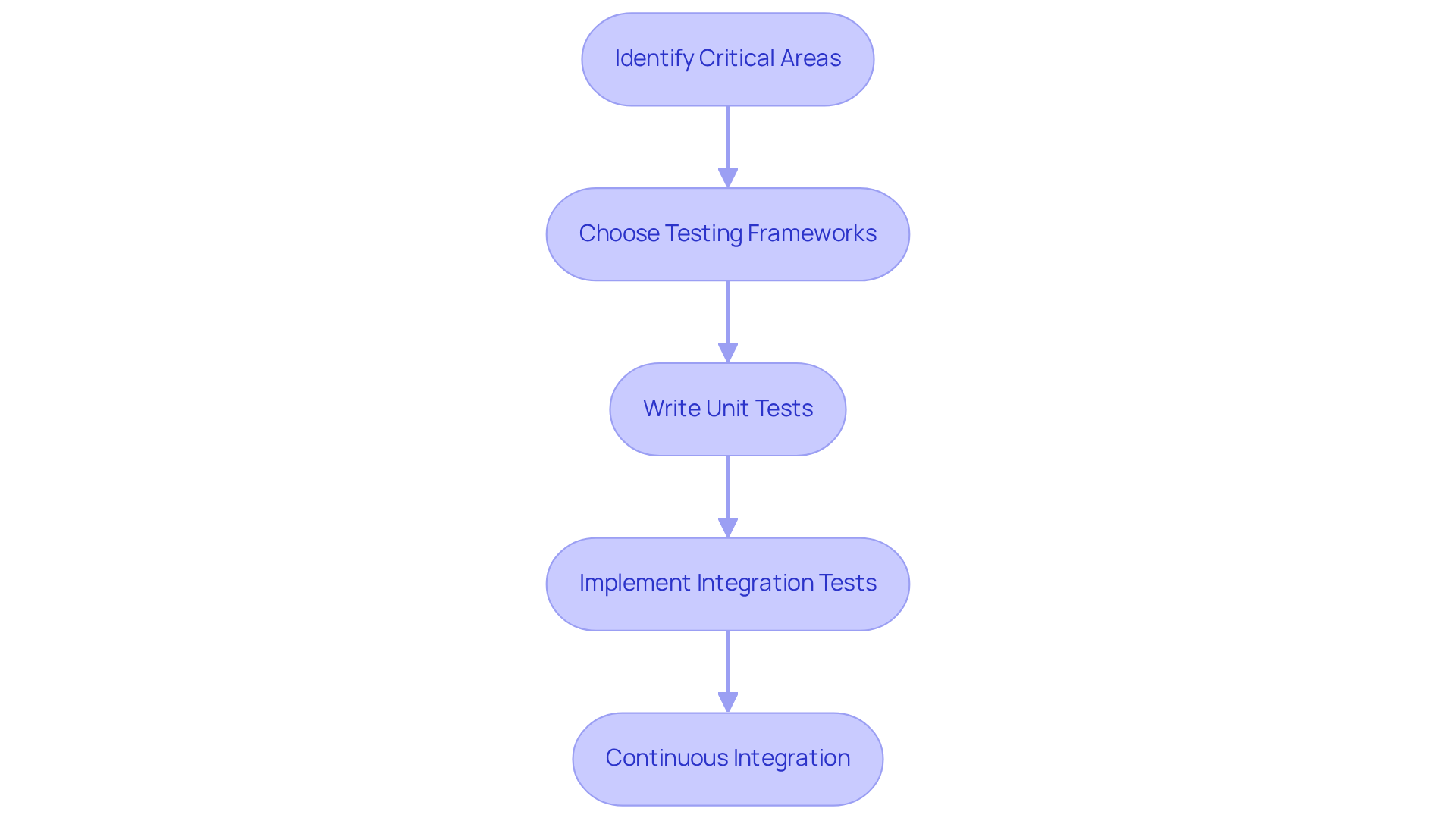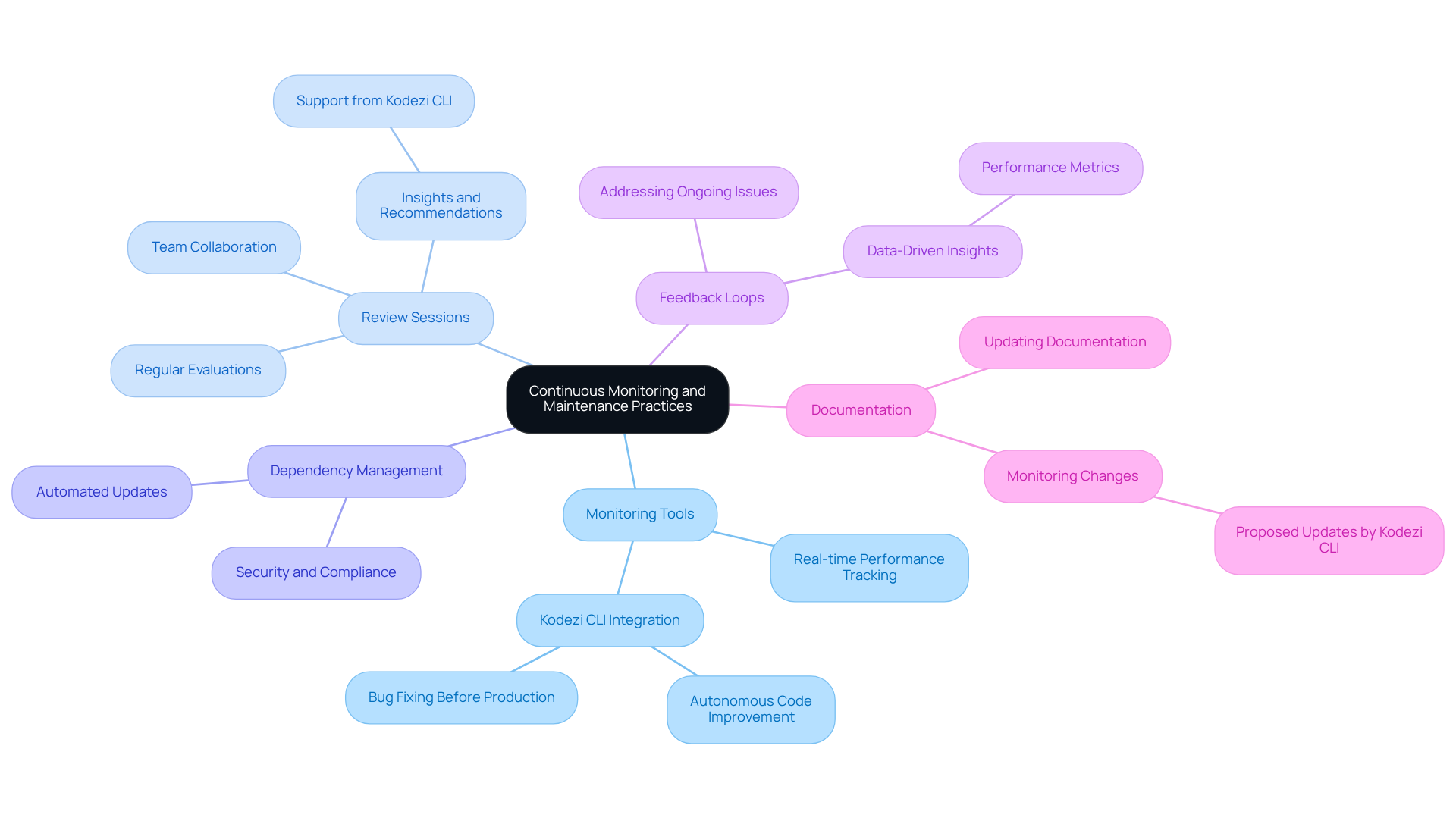Overview
Automated legacy code modernization can be a daunting task for developers facing numerous challenges. However, these challenges can be effectively addressed through four simple steps:
- Understanding legacy code complexities
- Implementing automated tools
- Integrating automated testing
- Establishing continuous monitoring practices
One tool that stands out in this process is Kodezi, which offers specific features designed to tackle these issues head-on.
By utilizing Kodezi, developers can significantly enhance their productivity and code quality. Imagine being able to streamline your modernization efforts while ensuring high software quality. With automated tools that simplify the coding process and robust testing strategies, Kodezi empowers developers to overcome obstacles that often hinder legacy code modernization.
Furthermore, continuous monitoring practices ensure that improvements are not only made but also sustained over time. This holistic approach to modernization not only addresses immediate pain points but also fosters long-term efficiency gains. Have you considered how adopting such tools could transform your coding practices?
In conclusion, exploring the tools available on the Kodezi platform can lead to remarkable advancements in your coding journey. Don't miss out on the opportunity to modernize your legacy code effectively and efficiently.
Introduction
Navigating the intricate landscape of legacy software can indeed pose significant challenges for developers. Outdated scripts, convoluted architectures, and insufficient documentation often complicate the development process. However, with the rise of automated legacy code modernization, there is a transformative opportunity to streamline these processes and enhance overall software quality.
As organizations increasingly prioritize modernization, one pressing question arises: how can teams effectively implement these automated solutions to tackle the complexities of legacy systems and cultivate a robust, efficient coding environment? Furthermore, exploring tools like Kodezi can provide valuable insights into overcoming these challenges, ultimately leading to improved productivity and code quality.
Understand Legacy Code and Its Challenges
Legacy software presents significant challenges that developers face, often stemming from outdated scripts, which can be addressed through automated legacy code modernization in older programming languages or frameworks. These challenges can severely impact development efficiency, leading to increased costs and project delays. How can teams overcome these obstacles?
-
Complexity is a major issue; legacy systems frequently feature convoluted architectures that make it difficult for developers to understand and modify the code. This complexity can lead to maintenance costs consuming 70-80% of IT budgets. Fortunately, Kodezi’s AI-driven programming tool can assist in reducing this complexity through automated legacy code modernization by automatically examining and rectifying scripts, allowing developers to focus on more strategic activities.
-
Another common pain point is the lack of documentation. Many legacy systems suffer from insufficient documentation, complicating the onboarding process for new developers and hindering their understanding of the program's purpose and functionality. This lack of clarity can result in costly errors and inefficiencies. Kodezi improves productivity by offering automatic bug explanations and creating comments, which serve as a form of documentation for outdated programs.
-
Technical debt is another critical concern. Over time, shortcuts taken during the creation process accumulate, resulting in a fragile codebase that is prone to bugs. This technical debt can lead to a 39% increase in maintenance costs as teams struggle to manage and rectify issues arising from outdated practices. Kodezi functions as an independent solution for B2B engineering teams, enhancing software quality through automated legacy code modernization and resolving issues before they enter production, thereby alleviating the strain of technical debt.
-
Furthermore, integration issues often arise from outdated programming, making it difficult to connect with contemporary tools and technologies. This limitation restricts efficiency in projects and hinders innovation. As organizations increasingly prioritize cloud-based solutions, 44% of IT professionals cite automated legacy code modernization and integration with modern tools as key goals for modernization. Kodezi supports more than 30 programming languages and is designed to work seamlessly with well-known IDEs such as Visual Studio Code, simplifying the process for teams to update their codebases and improve integration with modern coding environments.
Identifying these challenges is essential for successfully updating legacy systems. By understanding the complexities involved, teams can prioritize areas that require immediate attention and improvement. Kodezi not only addresses these challenges but also enhances development processes and outcomes. Explore the tools available on the platform to see how they can transform your coding practices.

Implement Automated Tools for Code Analysis and Refactoring
In the realm of software development, automated legacy code modernization poses a significant challenge for many developers. How can you navigate these complexities effectively? By implementing automated legacy code modernization tools, you can streamline this process and enhance your coding practices.
-
Static Program Analyzers like SonarQube and ESLint play a crucial role in identifying design flaws and vulnerabilities while ensuring compliance with programming standards. Regularly utilizing these tools can significantly boost code quality and mitigate technical debt.
-
Refactoring Tools within integrated development environments, such as JetBrains ReSharper, automate common tasks like renaming variables and extracting methods. This automation not only increases efficiency but also minimizes the risk of errors during the refactoring process.
-
Have you considered the impact of the Kodezi CLI? This versatile tool autonomously enhances your codebase, fixing bugs before they reach production. By automatically identifying and resolving issues, it optimizes performance and ensures security compliance, ultimately improving your programming productivity.
-
Documentation is another critical aspect of development. Tools such as Javadoc and Sphinx automatically generate documentation from comments in your code, ensuring that it remains up to date and accurately reflects your codebase.
Incorporating these tools into your development workflow aids in automated legacy code modernization by simplifying the analysis and refactoring of outdated software. Furthermore, it fosters a culture of continuous improvement and quality assurance. Explore the tools available on the Kodezi platform and elevate your coding practices today.

Integrate Automated Testing for Quality Assurance
Incorporating automated legacy code modernization into your initiatives is crucial for preserving software quality. Are you facing challenges in maintaining the integrity of your legacy systems? By following these essential steps, you can enhance your testing process and ensure your software remains robust.
-
Identify Critical Areas: Concentrate on the most vital aspects of your legacy system that need testing, such as core functionalities or areas with a history of bugs. Did you know that 48% of companies suffer from too much reliance on manual testing? This statistic underscores the importance of prioritizing this step.
-
Choose Testing Frameworks: Selecting appropriate testing frameworks tailored to your codebase is essential. For instance, JUnit is ideal for Java applications, while pytest suits Python projects. The right framework can streamline your testing process and enhance efficiency, making it easier to manage your testing efforts.
-
Write Unit Tests: Begin by creating unit tests for individual components of your program. Each test should cover specific functionalities, ensuring that even the smallest changes are verified. As Michael C. Feathers states, 'Software without tests is poor quality.' Effective unit tests should be fast and localized, facilitating quick feedback. The CLI can aid in this process by independently examining and rectifying scripts, guaranteeing that your unit tests rely on high-quality scripts.
-
Implement Integration Tests: After establishing unit tests, it's time to create integration tests to verify that different components work together as expected. This step is crucial for identifying issues that may arise when components interact, especially in complex legacy systems. Furthermore, the platform's capabilities in bug analysis can help identify integration issues early in the development cycle.
-
Continuous Integration: Setting up a CI/CD pipeline that automatically runs your tests whenever changes are made to the codebase is vital. With 36% of organizations enabling CI/CD through automated testing, this practice ensures that new software does not disrupt existing functionality, significantly lowering the risk of introducing new issues. Kodezi CLI can be incorporated into these pipelines, improving the automation of programming correction and bug fixing.
By establishing a strong automated legacy code modernization framework, you can confidently update your legacy systems while minimizing the risk of new defects. Adopting automated legacy code modernization not only enhances programming quality but also accelerates the development process, enabling teams to concentrate on innovation. In fact, 75% of organizations believe that test automation speeds up innovation, and the automation testing market is projected to grow at a 19.2% CAGR from USD 20.7 billion in 2021 to USD 49.9 billion by 2026. This growth underscores the importance of adopting these practices.

Establish Continuous Monitoring and Maintenance Practices
In the fast-paced world of software development, automated legacy code modernization poses significant challenges for developers. To navigate these hurdles effectively, implementing continuous monitoring and maintenance practices is essential.
Firstly, setting up robust monitoring tools is crucial. By utilizing these solutions, you can track application performance and identify anomalies in real-time. Furthermore, integrating Kodezi CLI can significantly enhance your monitoring efforts by autonomously improving your codebase and fixing bugs before they reach production.
In addition, arranging regular review sessions ensures that new implementations conform to established standards and best practices. These frequent evaluations not only enhance software quality but also foster a culture of teamwork and ongoing education within your team. The CLI can further support this process by providing insights and recommendations for improvements.
Moreover, automating dependency management is vital. Implementing tools that automatically update dependencies keeps your codebase secure and up-to-date. The CLI enhances this by independently tackling programming issues, allowing your teams to focus on strategic tasks.
Establishing feedback loops with your development team is another key practice. These loops help address ongoing issues and identify areas for improvement. Utilizing the CLI can enhance these discussions by offering data-driven insights into programming performance and pinpointing areas requiring focus.
Lastly, consistently updating documentation is critical to reflect changes made during modernization efforts. The CLI can assist in maintaining precise documentation by monitoring changes and proposing updates based on code alterations.
By adopting these practices and leveraging the capabilities of Kodezi CLI, you can ensure automated legacy code modernization while maintaining a clean, efficient, and modern codebase that evolves with your organization's needs. Why not explore the tools available on the platform to enhance your development process today?

Conclusion
Automated legacy code modernization is crucial for enhancing software quality and enabling development teams to effectively navigate the complexities of outdated systems. By leveraging advanced tools and methodologies, organizations can address the challenges posed by legacy code, which leads to improved efficiency and reduced costs.
Key arguments throughout this article underscore the significant obstacles that legacy systems present, including:
- Complexity
- Lack of documentation
- Technical debt
- Integration issues
Implementing automated tools for code analysis and refactoring, integrating automated testing, and establishing continuous monitoring practices are essential steps in overcoming these hurdles. Tools like Kodezi’s AI-driven programming solutions streamline modernization efforts, enhance collaboration, and ultimately foster a more agile development process.
In a rapidly evolving technological landscape, the importance of tackling legacy code challenges cannot be overstated. Organizations that adopt automated legacy code modernization will not only enhance their code quality but also cultivate a culture of continuous improvement and innovation. As the demand for modernized systems increases, proactively integrating these practices will empower teams to remain competitive and responsive to changing market needs.
Frequently Asked Questions
What are the main challenges of working with legacy code?
The main challenges include complexity due to convoluted architectures, lack of documentation, accumulation of technical debt, and integration issues with modern tools and technologies.
How does complexity in legacy systems affect development?
Complexity can make it difficult for developers to understand and modify the code, leading to maintenance costs that consume 70-80% of IT budgets and increased project delays.
What role does Kodezi play in addressing legacy code challenges?
Kodezi’s AI-driven programming tool assists in reducing complexity through automated legacy code modernization, allowing developers to focus on more strategic activities by automatically examining and rectifying scripts.
How does the lack of documentation impact new developers working with legacy systems?
Insufficient documentation complicates the onboarding process for new developers, hindering their understanding of the program's purpose and functionality, which can result in costly errors and inefficiencies.
What features does Kodezi offer to improve documentation for legacy code?
Kodezi improves productivity by offering automatic bug explanations and creating comments, which serve as a form of documentation for outdated programs.
What is technical debt, and why is it a concern in legacy systems?
Technical debt refers to the shortcuts taken during the creation process that accumulate over time, resulting in a fragile codebase prone to bugs. It can lead to a 39% increase in maintenance costs as teams struggle to manage these issues.
How does Kodezi help mitigate technical debt?
Kodezi enhances software quality through automated legacy code modernization and resolves issues before they enter production, alleviating the strain of technical debt.
What integration issues do legacy systems face?
Outdated programming can make it difficult to connect legacy systems with contemporary tools and technologies, hindering efficiency and innovation.
What are the goals of IT professionals regarding legacy code modernization?
44% of IT professionals cite automated legacy code modernization and integration with modern tools as key goals for modernization.
How does Kodezi support integration with modern coding environments?
Kodezi supports more than 30 programming languages and is designed to work seamlessly with well-known IDEs such as Visual Studio Code, simplifying the process for teams to update their codebases.




